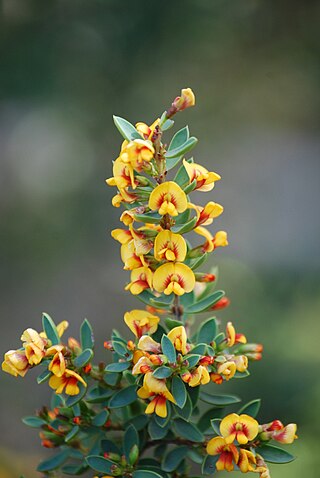
Eutaxia is a genus of the family Fabaceae. They are native to Australia. Most are endemic to the Southwest Botanical Province of Western Australia, but a few are distributed throughout mainland Australia. The chromosome number of Eutaxia species is typically 2n = 14 or 16.
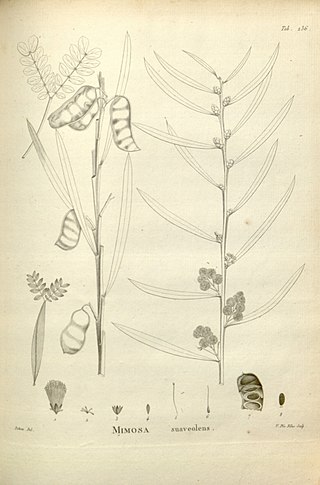
Phyllodes are modified petioles or leaf stems, which are leaf-like in appearance and function. In some plants, these become flattened and widened, while the leaf itself becomes reduced or vanishes altogether. Thus the phyllode comes to serve the purpose of the leaf. Some important examples are Euphorbia royleana which are cylindrical and Opuntia which are flattened.

Lasiopetalum, commonly known as velvet bushes, is a genus of about forty-five species of flowering plants in the family Malvaceae, all endemic to Australia.
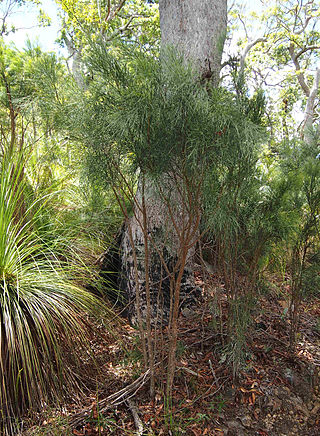
Jacksonia scoparia, commonly known as dogwood, is a native species of a pea-flowered, greyish, leafless, broom-like shrub or small tree that occurs in the south east of Queensland, Australia and eastern New South Wales.
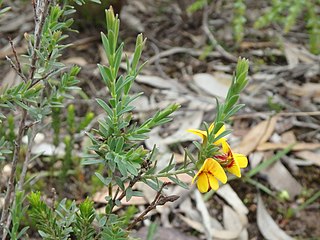
Eutaxia diffusa, commonly known as spreading eutaxia, is a shrub species in the family Fabaceae. The species is endemic to Australia.

Eutaxia microphylla, also known as common eutaxia, is a shrub species in the family Fabaceae. The species is endemic to Australia.
Eutaxia empetrifolia is a shrub species in the family Fabaceae. The species is endemic to Australia. It occurs in South Australia and the south-west of Western Australia.

Dicrastylis is a genus of plants in the Lamiaceae, first described in 1855. The entire genus is endemic to Australia. The type species is Dicrastylis fulva.

The Mirbelioids are an informal subdivision of the plant family Fabaceae that includes the former tribes Bossiaeeae and Mirbelieae. They are consistently recovered as a monophyletic clade in molecular phylogenies. The Mirbelioids arose 48.4 ± 1.3 million years ago. Members of this clade are mostly ericoid (sclerophyllous) shrubs with yellow and red flowers found in Australia, Tasmania, and Papua-New Guinea. The name of this clade is informal and is not assumed to have any particular taxonomic rank like the names authorized by the ICBN or the ICPN. Members of this clade exhibit unusual embryology compared to other legumes, either enlarged antipodal cells in the embryo sac or the production of multiple embryo sacs. There has been a shift from bee pollination to bird pollination several times in this clade. Mirbelioids produce quinolizidine alkaloids, but unlike most papilionoids, they do not produce isoflavones. Many of the Mirbelioids have pseudoraceme inflorescences.
Maxwellia lepidota is a species of shrubs or trees in the family Malvaceae. It is endemic to New Caledonia and the only species of the monotypic genus Maxwellia. Its closest relatives are all Australian genera in tribe Lasiopetaleae: Guichenotia, Hannafordia, Lysiosepalum, Lasiopetalum and Thomasia.

Michael Douglas Crisp is an emeritus professor in the Research School of Biology at the Australian National University located in Canberra. In 1976, he gained a PhD from the University of Adelaide, studying long-term vegetation changes in arid zones of South Australia. In 2020, Crisp moved to Brisbane, where he has an honorary position at the University of Queensland. Together with colleagues, he revised various pea-flowered legume genera.
Lindy Webster Cayzer CF is an Australian botanist.
Malcolm Eric Trudgen is a West Australian botanist. He has published some 105 botanical names. He currently runs his own consulting company, ME Trudgen and Associates.

Stenopetalum is a genus in the Brassicaceae family which is endemic to Australia. It was first described by Robert Brown in 1821.
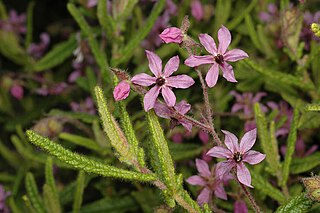
Lysiosepalum abollatum, also known as woolly lysiosepalum, is a species of flowering plant in the family Malvaceae and is endemic to a small area in the south-west of Western Australia. It is an erect, dense shrub covered with white, woolly hairs, and has narrowly egg-shaped leaves and pink, blue or purple flowers usually in groups of four or five.
Lysiosepalum aromaticum is a species of flowering plant in the family Malvaceae and is endemic to a small area in the south-west of Western Australia. It is thick, bushy shrub with a strong, aromatic scent, most parks covered with white, star-shaped hairs and red-tipped, club-shaped hairs, and has egg-shaped to broadly egg-shaped leaves and pinkish-purple flowers usually in groups of two to four.

Seringia exastia, also known as fringed fire-bush, is a species of flowering plant in the mallow family and is endemic to northern Western Australia. It is an erect, compact shrub with hairy young branches, narrowly egg-shaped, elliptic or oblong leaves and purple flowers arranged in groups of 7 to 9.
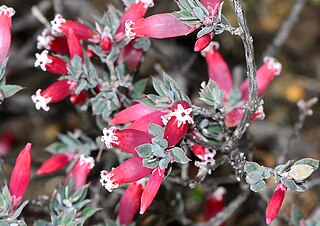
Styphelia stricta is a small plant in the family Ericaceae. It is endemic to Western Australia.

Jacksonia anthoclada is a plant in the Fabaceae family. It is endemic to Western Australia.

Maireana thesioides is a plant in the Amaranthaceae family, native to Western Australia.














